Modular Optical Tweezers
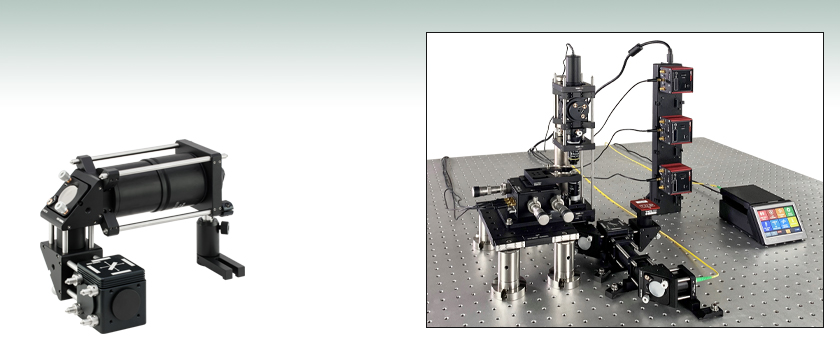
- Configurable for Research and Advanced Lab Courses
- Inverted Microscope Design
- 976 nm Trap Laser; Other Wavelengths Available
- Modules Available for Back Focal Plane Detection
and Fluorescence Microscopy
OTKB-FL
Fluorescence
Microscopy Module
(Optional Add-On)
OTKB
Shown Assembled
on a Breadboard
(Not Included)

Please Wait
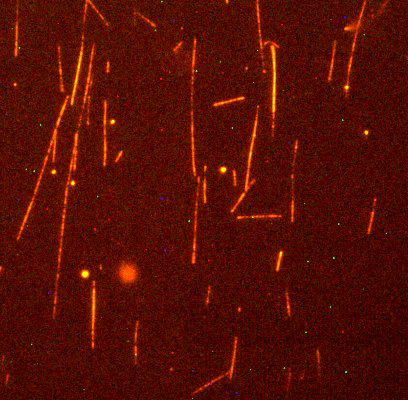
Fluorescence Image of an actin network stained with rhodamine phalloidin (Excitation: 540 nm, Emission: 565 nm) acquired by our Modular Optical Tweezers with the optional Fluorescence Module. (Viewed with a N100X-PFO Nikon planfluorite 100X oil immersion objective, 1.3 NA.)
Features
- Complete Optical Trapping System
- Inverted Light Microscope Design Ideal for In Vitro Biological Experiments
- 976 nm, 300 mW Trap Laser with Easy-to-Use Touch Screen Controller
- Nikon 100X Oil Immersion Objective
- 3-Axis Sample Positioning Stage with Integrated Piezo Actuators for Nanometer Resolution
- CMOS Camera with USB Interface for Video Imaging
- Back Focal Plane Detection and Fluorescence Microscopy Modules Available
Thorlabs' OTKB(/M) Modular Optical Tweezers provide users with a tool for trapping and manipulating microscopic-sized objects. These laser-based tweezers, or traps, have been employed in numerous biological experiments. Biological applications for optical tweezers include trapping viruses and bacteria, manipulating cellular structures, patterning of surfaces, and measuring forces of molecular motors and biological molecules such as DNA and proteins. For more details on experiments performed using Thorlabs tweezers, please see the Videos and Publications tabs. The Technology tab provides more details on the functionality of optical tweezers.
Our modular optical tweezers have the flexibility required for experiments conducted in advanced research laboratories. The system is based on an inverted microscope design that provides compatibility with standard samples. It is offered with a CMOS camera for video imaging, and the system can be easily adopted for fluorescence, single-molecule, and other types of microscopy. The advantage to purchasing and assembling this modular system is the versatility it provides over other closed optical tweezers systems. Since the optical tweezers are built using standard Thorlabs components, it is easy to modify or upgrade the system using other standard components.
System Modularity and Assembly
The tweezers system is shipped in pre-assembled segments, which can be assembled on a user-provided optical table or breadboard. A walkthrough of the system setup and alignment is provided on the Videos tab. More details about each of the segments included in the base OTKB system, as well as optional components, can be found on the System tab. A step-by-step assembly instruction manual is included with each system. For an additional cost, we are able to provide a system that has been pre-assembled, aligned, and tested on a breadboard; please contact Tech Support with inquiries.
For initial testing and alignment, the OTKBTK Sample Preparation Kit sold below provides users with everything necessary to prepare a sample and verify that the optical tweezer system is assembled correctly and functioning.
Optional Modules
One of the principal advantages of the OTKB(/M) optical tweezers system over a black box system is the ease with which the design of the optical trap can be modified to add functionality. For example, the OTKBFM can be easily attached to the base OTKB kit to provide the user with a module capable of detecting the back focal plane. This can be used to add trapping force, stiffness, and position measurement capabilities to the OTKB optical trap.
Laser Safety
Whenever operating a laser, it is imperative to pay attention to the classification of the laser and observe appropriate laser safety procedures. Thorlabs' Modular Optical Tweezers System uses a 976 nm, 300 mW laser. Exposure to the laser beam is possible, and the system should be treated as a Class 3B laser. Appropriate safety procedures and care must be taken including, but not limited to, the use of laser safety glasses. More details about the laser classification system and Thorlabs laser safety products can be found in the Laser Safety tab.
| Item # | OTKB(/M)a |
|---|---|
| Tweezer Specifications | |
| Trap Force | ~10 pNb |
| Spot Size | 1.1 µm |
| Depth of Focus | 1 µm |
| Laser Wavelength | 976 nm |
| Max Power at Fiber Output | 300 mW |
| Objective Specificationsc | |
| Type | Nikon 100X Immersion Objective |
| Numerical Aperture | 1.25 |
| Input Aperture | Ø5 mm |
| Working Distance | 0.23 mm |
| Wavelength Range | 380 - 1100 nm |
| Recommended Cover Glass Thickness | 0.17 mm |
| Condenser Lens Specifications | |
| Type | Nikon 10X Air Condenser |
| Numerical Aperture | 0.25 |
| Working Distance | 7 mm |
| Wavelength Range | 380 - 1100 nm |
Click on the OTKB modules in the photo below to find out more details.
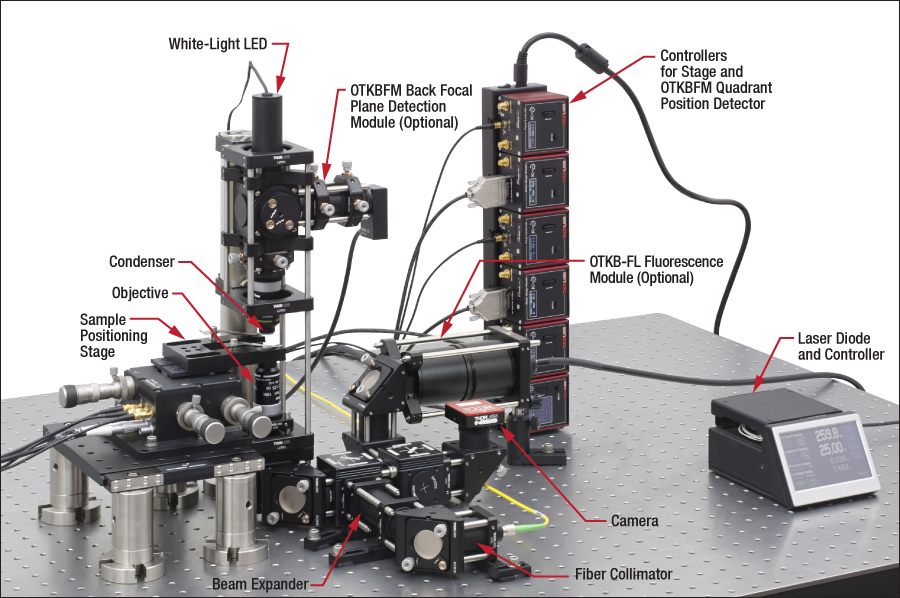
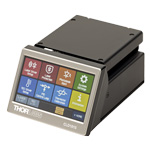
Click to Enlarge
Laser Diode Mount
Laser Input and Collimation
The 976 nm trapping laser source is a pigtailed Fiber Bragg Grating (FBG) stabilized single mode laser diode in a hermetically sealed 14-pin butterfly package. The integrated TEC element and thermistor in the butterfly package allow the temperature of the laser to be precisely controlled with our CLD1015 laser diode / TEC controller and mount. This laser, mount, and controller combination was chosen to ensure that the output power of the laser will be very stable, which is important for maintaining a constant trapping force. The laser input is collimated using one of our triplet fiber collimators to provide excellent beam quality and ease of alignment.
Beam Expander
This beam expander is based on Galilean expansion, which minimizes overall space while providing an expansion factor of 3. We use anti-reflection coated achromatic doublets (Item #'s ACN254-050-B and AC254-150-B) that are computer-optimized at infinite conjugate ratios to expand the collimated trapping laser beam. The beam expander uses cage rods assembled in such a way that they allow the user to optimize the divergence of the trapping beam, which can be used to adjust the Z-position of the trapping plane, by allowing up to 12.5 mm adjustment along the optical axis.
Objective and Condenser
A 100X oil immersion Nikon objective lens with a numerical aperture of 1.25 is provided with the OTKB. This lens is used to focus the laser beam down to a spot size of 1.1 µm. For additional applications, such as trapping of higher index polystyrene beads, we offer objectives below with a higher NA of 1.3.
After traveling through the sample, the light is collimated by the condenser lens. The condenser is a Nikon 10X air condenser with a numerical aperture of 0.25.
Stage
The sample stage consists of a microscope slide holder (Item # MAX3SLH) mounted to a 3-axis (X, Y, Z) translation stage. This stage is then mounted on a translating breadboard, which results in the following capabilities:
- 2.4" (60 mm) of travel perpendicular to the beam path using a TBB0606 (TBB1515/M) translating breadboard. This makes it easy to load the sample and coarsely position it near the trap.
- 4 mm of travel in the X, Y, and Z directions using the MAX311D(/M) NanoMax stage with differential micrometer drives. The coarse adjustment knobs provide 0.5 mm/rev.
- 300 µm of travel in the X, Y, and Z directions using the differential knobs (50 µm/rev) on the NanoMax stage.
- 20 µm of travel in the X, Y, and Z directions using the piezo actuators on the 3-axis stage. 20 nm resolution is possible with the OTKB(/M), as no strain gauge readers are provided. 5 nm resolution can be achieved using the internal strain gauges for positional feedback; two K-Cube™ Strain Gauge Readers (Item # KSG101*) are included with the OTKBFM Force Module. Three Piezo Drivers are included in the OTKB(/M).
*The KSG101 is no longer available for individual sale. Please contact Tech Support if a replacement is needed.
Camera Module and LED Source
Visible light from the LED source illuminates the sample and is then imaged on the 1440 x 1080 pixel color CMOS camera (Item # CS165CU1) using an achromatic doublet (Item # AC254-200-A-ML). The dichroic mirror in the light path in combination with a shortpass filter prevents backscattered light from the 976 nm laser from saturating the CMOS sensor after its IR filter has been removed. With the camera, you can acquire still images or video both in color or monochrome black and white.
Controllers for the Sample Stage and the Optional OTKBFM Force Module
The controllers for both the stage and OTKBFM force module are from our compact Kinesis® K-Cube product family. These compact (60 mm x 60 mm x 47 mm [2.4" x 2.4" x 1.9"]) controllers are provided with our USB controller hub, which provides power and single-USB-cable control of up to 6 controllers. The hub can be mounted either vertically (as shown above) or horizontally depending on space constraints.
For additional information on the three piezo drivers included with the kit or the two strain gauge readers provided with the OTKBFM force module, please see the stage or force module sections, respectively.
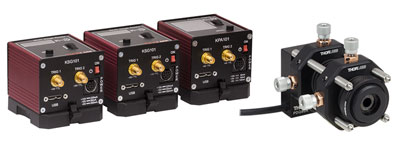
Click to Enlarge
OTKBFM Back Focal Plane Detection Module Components:
K-Cube Quadrant Detector and Strain Gauge Readers (Left) and
Optomechanical Module with Quadrant Detector (Right)
Back Focal Plane and Force Acquisition Modules
In order to use an optical tweezers setup for quantitative force measurements, the position of the trapped particle has to be monitored. For high-bandwidth / high-resolution measurements, a Quadrant Position Detector (QPD) can be placed in a plane conjugate to the back focal plane of the condenser. In that case, the signal generated by the QPD is sensitive to the relative displacement of the trapped particle from the trap center, and can be used to determine the position, stiffness, and force of the optical tweezers. The optional OTKBFM module includes a QPD, optomechanics, and controllers to add back focal plane detection to our OTKB modular tweezers setup. The controllers consist of a KPA101 K-Cube Quadrant Detector Reader and two previous-generation KSG101 K-Cube Strain Gauge Readers. This module does not include any data acquisition (DAQ) hardware or software to capture and analyze the data; it is therefore ideal for users who plan to use existing DAQ hardware and analysis software.
Due to the sensitivity of these measurements, we usually recommend using an active isolation support for mounting a system containing an OTKBFM.
For more details on force measurement and calibration techniques, please see the Technology tab.
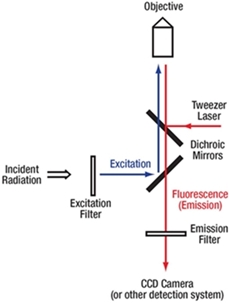
Fluorescence Beam Path
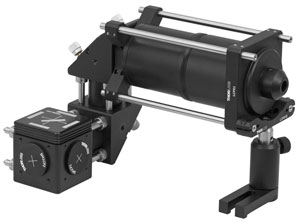
Click to Enlarge
OTKB-FL Fluorescence Microscopy Module
Fluorescence Microscopy Module
By combining fluorescence microscopy with optical tweezers, researchers can visualize, manipulate, and rapidly characterize the properties of various samples and cellular structures. Such techniques can be used to detect the arrival of a single molecule into a small volume, detect the conformational changes of cellular structures or bacteria, study elastic properties of a single DNA molecule, demarcate different parts of a larger molecular complex, and measure the response of each to an applied force. Thorlabs provides a tested set of components as a module that enables the addition of such functionalities to our Optical Tweezers Kit, as shown in the photo to the right.
Fluorescence imaging filters can be easily be inserted or removed with the included quick-change filter cube. To allow users flexibility in choosing fluorophores, an imaging filter set is not included with the fluorescence module; Thorlabs offers fluorescence imaging filters for a variety of common fluorophores that are available separately.
Also recommended is a plan fluorite or semi-apochromatic objective such as the RMS100X-PFO or N100X-PFO (both sold below). The plan fluorite and semi-apochromatic design provides a wider corrected wavelength range ideal for fluorescence microscopy. These objectives have a higher numerical aperture than the standard objective included with the OTKB, allowing them to trap particles like polystyrene that are functionalized and typically used as a probe.
As an application example, consider a sample consisting of a diluted solution of 1.0 µm uniformly FITC-dyed polystyrene beads, with an excitation wavelength of 480 nm and an emission wavelength of 520 nm. The excitation light is selected from a broadband source using a MF475-35 excitation filter, which has a transmission of more than 85% in the 470 - 490 nm range. The light is then coupled into the tweezers system using an MD499 dichroic mirror, which reflects light in the 470 - 490 nm range and transmits light in the 508 - 675 nm range, as shown in the schematic to the far right. As with any standard epi-fluorescence technique, the fluorescence light emitted by the sample will be collected by the objective together with any reflected excitation light, which gives a better signal-to-noise ratio than a transmissive detection scheme. The signal then goes back through the dichroics and an MF530-43 emission filter which has a center wavelength of 530 nm and a 43 nm FWHM bandwidth, and is then detected by a CMOS camera. The CMOS camera can also be replaced by a photodiode for quantitative measurements or a scientific camera for higher-quality fluorescence images.
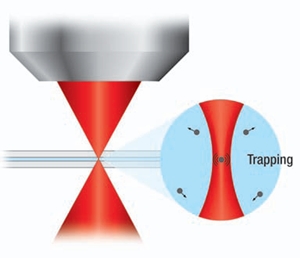
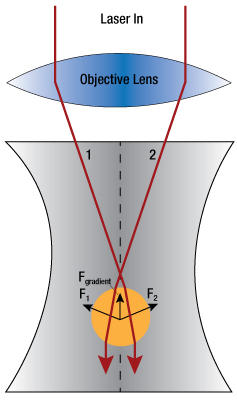
Click to Enlarge
Schematic showing the net gradient force on a particle (larger than the wavelength of light) in a focused laser beam.
Basic Theory of Optical Tweezers
Optical Tweezers, or traps as they are often called, are created by using a high numerical aperture objective to tightly focus a laser beam, thereby creating a spot where a particle with dimensions on the order of microns will experience a force due to transfer of momentum from the scattering of photons.
Arthur Ashkin in the early 1970s originally demonstrated that optical forces can manipulate micro-sized dielectric particles in water (A. Ashkin. Phys. Rev. Lett. 24, 156 - 159 [1970] and A. Ashkin et al. Opt. Lett. 1, No. 5, [1986]). This technique has become an important tool in a wide range of fields such as bioengineering, material science, and physics due to its ability to hold and manipulate particles and to measure forces in the femtonewton and piconewton ranges.
The relationship between particle size and the trapping wavelengths presents two regimes to consider when developing a theory to describe optical trapping. In the Mie size regime, the diameter of a trapped particle is much larger than the wavelength of light and trapping can be described using ray optics. Rays of light are refracted as they pass through the particle, exerting a force due to the momentum change. In the case where a particle is not aligned axially in the center of the laser beam, the rays closer to the center of the beam will be more intense and will transfer more momentum to the particle than those rays closer to the edge of the beam. This will apply a lateral "gradient" force to the particle towards the center of the beam. Once the particle is in the center of the beam, the rays refracting through the particle will be symmetric, and the particle will be laterally trapped.
The forces in the axial direction are more complex. As rays are backscattered at the solvent-particle interface, the light will transfer momentum to the particle, leading to a scattering force in the forward direction of the beam. With a particle near the focus of a laser beam, the gradient force Fgradient will act towards the focus, as shown in the schematic below and to the right. The resulting overall potential has the minimum slightly offset downstream from the focus of the beam. In order to trap particles in the image plane of the microscope, the laser focus has to be slightly offset to compensate for the scattering force.
In the Rayleigh regime, the diameter of the particle is much smaller than the wavelength and the ray theory breaks down. To understand the forces, the trapped particle is considered to be a point dipole. The scattering force arises from absorption and re-radiation, while the gradient force results from the interaction between the inhomogeneous field and the induced dipole (C. N. Keir and M. B. Steven. Review of Scientific Instruments 75, No. 9, 2004).
For particle sizes comparable to the wavelength, neither the Mie theory nor the Rayleigh theory applies; therefore, the electromagnetic field analysis is more complex. There are several references detailing this theory, such as E. Almaas and I. Brevik. J. Opt. Soc. Am. B 12, 2429, 1995; J. P. Barton, J. Appl. Phys. 64, 1632 (1988); P. Zemanek et al. J. Opt. Soc. Am. A 19, 1025 (2002); K. F. Ren et al. Opt. Commun. 108, 343 (1994).
Measuring Forces with Optical Tweezers
The capability of optical tweezers to measure forces on particles offers a unique and valuable tool for studying cell components such as biological proteins and molecular motors. Optical tweezers apply a force toward the focus of the trapping laser beam with a magnitude proportional to the distance of the particle from the focus for small displacements from the center of the trap. As the laser beam passes through a trapped particle, it will be deflected by an amount that depends on the position of the particle relative to the center of the trap. This allows the optical tweezers to be modeled by Hooke's law, Fi = -kixi, where ki is the force (spring) constant and xi is the displacement from the center of the trap.
As the laser beam passes through the sample plane, interference occurs between the light that is transmitted through the trapped particle and the remainder of the light. As a consequence, the interference pattern at the back focal plane of the condenser depends on the distance of the trapped particle to the trap center. The deflection is converted to an electrical signal by a quadrant photodiode, which produces a voltage proportional to the particle position through this back focal plane interferometry (F. Gittes and C. F. Schmidt. Opt. Lett. 23, No. 1, 1998).
The data acquired from the QPD is given in volts. For quantitative force and position measurements it is necessary to determine the detector responsivity factor. One method requires a stuck bead to be moved across the location of the trap while recording the detector voltage. Using the sample stage, steps of known size can be used that then allow plotting of the position signal in volts versus the position signal in microns. When the bead moves across the trap position an S-shaped curve is formed.
Accurate force measurements also depend on precise calibration of the force constant and the responsivity of the particle position detector, which varies with laser power and particle properties. Common methods for ascertaining the force constant are Power Spectral Density (PSD) roll-off, equipartition, and Stokes' drag.
In the PSD roll-off method, the power spectral density of a time series of trapped particle positions (due to Brownian motion) is computed. This is fit to the response of a harmonic oscillator with known damping due to the viscosity of the solvent and is described by the equation:

Here, Svv is the uncalibrated power spectrum, ρ is the linear voltage displacement calibration factor, kB is Boltzmann's constant, T is the temperature of the medium, β is the drag coefficient, and f0 is the characteristic corner (roll-off) frequency. A sample PSD curve is shown in the screenshot below and to the right. The PSD roll-off method offers a particularly effective way to discover an inaccurate position detector calibration, since it does not depend on the detector responsivity like the other two methods.
The equipartition method equates the average potential energy of the particle in the trap to the thermal energy of the solvent molecules. The force constant ki is determined using the equation
In the Stokes method, the sample is translated with a range of velocities. A force balance between viscous drag on the particle and the trap force is computed. Since each method relies on a different physical principle, the combined results provide a convenient way to verify the calibration.
Modular Optical Tweezers Installation
The video below provides a walkthrough of the setup and alignment process for the OTKB system. Note that this video contains several previous-generation components, which have since been replaced by their current catalog equivalents. New kits include the components listed in the Shipping List chapter of the manual.
Optical Trapping of Nanoparticles
Bergeron, J., Zehtabi-Oskuie, A., Ghaffari, S., Pang, Y., Gordon, R. Optical Trapping of Nanoparticles. J. Vis. Exp. (71), e4424, doi:10.3791/4424 (2013).
In the video below, a modified OTKB system is utilized to trap 20 nm polystyrene nanospheres. This is accomplished by using a double nanohole structure, which produces a large trapping force that allows nanometer-sized particles to be trapped.
An Introduction to Optical Trapping
In the video below, Steve Wasserman and Steven Nagel of the Bioinstrumentation Teaching Lab in the MIT Department of Biological Engineering explain the basics of optical trapping and methods for calibrating optical traps using our modular optical tweezers kit.
The following papers describe research and education using Thorlabs' OTKB Modular Optical Tweezers. To learn how our tweezers might benefit your research, please contact techsupport@thorlabs.com.
Research Articles
Roder, P. B., Manandhar, S., Smith, B. E., Zhou, X., Shutthanandan, V. S. and Pauzauskie, P. J. Photothermal Superheating of Water with Ion-Implanted Silicon Nanowires. Advanced Optical Materials, 3, 1362, 2015.
Benjamin J. Gross and Mohamed Y. El-Naggar. A combined electrochemical and optical trapping platform for measuring single cell respiration rates at electrode interfaces. Rev. Sci. Instrum. 86, 064301, 2015
W. N. Wan Aziz, S. K. Ayop, and S. Riyanto. The Potential of Optical Tweezer (OT) for Viscoelastivity Measurement of Nanocellulose Solution. Jurnal Teknologi 74, 45, 2015.
Gusachenko, I.; Truong, V.G.; Frawley, M.C.; Nic Chormaic, S. Optical Nanofiber Integrated into Optical Tweezers for In Situ Fiber Probing and Optical Binding Studies. Photonics 2, 795, 2015.
Abhay Kotnala, Skyler Wheatona, and Reuven Gordon. Playing the notes of DNA with light: extremely high frequency nanomechanical oscillations. Nanoscale 7, 2295, 2015.
Skyler Wheaton, Ryan M. Gelfand, and Reuven Gordon. Probing the Raman-active acoustic vibrations of nanoparticles with extraordinary spectral resolution. Nature Photonics 9, 68, 2015.
Pick Chung Lau, Zhaozhao Zhu, Robert A. Norwood, Masud Mansuripur, and Nasser Peyghambarian. Thermally robust and blinking suppressed core/graded-shell CdSe/CdSe1−xSx/CdS 'giant' multishell semiconductor nanocrystals. Nanotechnology 24, 475705.
Kuan-Yu Chen, An-Ting Lee, Chia-Chun Hung, Jer-Shing Huang, and Ya-Tang Yang. Transoport and Trapping in Two-Dimensional Nanoscale Plasmonic Optical Lattice. Nano Lett 13, 4418, 2013.
Yuanjie Pang and Reuven Gordon. Optical Trapping of a Single Protien. Nano Lett 12, 402, 2012.
Corey Butler, Shima Fardad, Alex Sincore, Marie Vangheluwe, Matthieu Baudelet, and Martin Richardson. Multispectral optical tweezers for molecular diagnostics of single biological cells. Proc. SPIE 8225 82250C-1, 2012.
Ana Zehtabi-Oskuie, Jarrah Gerald Bergeron, and Reuven Gordon. Flow-dependent double-nanohole optical trapping of 20 nm polystyrene nanospheres. Scientific Reports 2, 966, 2012.
Yuhang Jin and Kenneth B. Crozier. An optical manometer-on-a-chip. Proc. SPIE 8097 80971U, 2011.
Educational Materials
Optical Tweezers. Abbe School of Photonics, Friedrich-Schiller-Universität, Physikalisch-Astronomische-Fakultät, 2010.
Aleksandra Radenovic. Optical Trapping. Advanced Bioengineering Methods Laboratory, École Polytechnique Fédérale de Lausanne.
D. C. Appleyard, K. Y. Vandermeulen, H. Lee, and M. J. Lang. Optical Trapping for Undergraduates. Am. J. Phys. 75 (1), January 2007.
Laser Safety and Classification
Safe practices and proper usage of safety equipment should be taken into consideration when operating lasers. The eye is susceptible to injury, even from very low levels of laser light. Thorlabs offers a range of laser safety accessories that can be used to reduce the risk of accidents or injuries. Laser emission in the visible and near infrared spectral ranges has the greatest potential for retinal injury, as the cornea and lens are transparent to those wavelengths, and the lens can focus the laser energy onto the retina.
Safe Practices and Light Safety Accessories
- Laser safety eyewear must be worn whenever working with Class 3 or 4 lasers.
- Regardless of laser class, Thorlabs recommends the use of laser safety eyewear whenever working with laser beams with non-negligible powers, since metallic tools such as screwdrivers can accidentally redirect a beam.
- Laser goggles designed for specific wavelengths should be clearly available near laser setups to protect the wearer from unintentional laser reflections.
- Goggles are marked with the wavelength range over which protection is afforded and the minimum optical density within that range.
- Laser Safety Curtains and Laser Safety Fabric shield other parts of the lab from high energy lasers.
- Blackout Materials can prevent direct or reflected light from leaving the experimental setup area.
- Thorlabs' Enclosure Systems can be used to contain optical setups to isolate or minimize laser hazards.
- A fiber-pigtailed laser should always be turned off before connecting it to or disconnecting it from another fiber, especially when the laser is at power levels above 10 mW.
- All beams should be terminated at the edge of the table, and laboratory doors should be closed whenever a laser is in use.
- Do not place laser beams at eye level.
- Carry out experiments on an optical table such that all laser beams travel horizontally.
- Remove unnecessary reflective items such as reflective jewelry (e.g., rings, watches, etc.) while working near the beam path.
- Be aware that lenses and other optical devices may reflect a portion of the incident beam from the front or rear surface.
- Operate a laser at the minimum power necessary for any operation.
- If possible, reduce the output power of a laser during alignment procedures.
- Use beam shutters and filters to reduce the beam power.
- Post appropriate warning signs or labels near laser setups or rooms.
- Use a laser sign with a lightbox if operating Class 3R or 4 lasers (i.e., lasers requiring the use of a safety interlock).
- Do not use Laser Viewing Cards in place of a proper Beam Trap.
Laser Classification
Lasers are categorized into different classes according to their ability to cause eye and other damage. The International Electrotechnical Commission (IEC) is a global organization that prepares and publishes international standards for all electrical, electronic, and related technologies. The IEC document 60825-1 outlines the safety of laser products. A description of each class of laser is given below:
| Class | Description | Warning Label |
|---|---|---|
| 1 | This class of laser is safe under all conditions of normal use, including use with optical instruments for intrabeam viewing. Lasers in this class do not emit radiation at levels that may cause injury during normal operation, and therefore the maximum permissible exposure (MPE) cannot be exceeded. Class 1 lasers can also include enclosed, high-power lasers where exposure to the radiation is not possible without opening or shutting down the laser. |  |
| 1M | Class 1M lasers are safe except when used in conjunction with optical components such as telescopes and microscopes. Lasers belonging to this class emit large-diameter or divergent beams, and the MPE cannot normally be exceeded unless focusing or imaging optics are used to narrow the beam. However, if the beam is refocused, the hazard may be increased and the class may be changed accordingly. |  |
| 2 | Class 2 lasers, which are limited to 1 mW of visible continuous-wave radiation, are safe because the blink reflex will limit the exposure in the eye to 0.25 seconds. This category only applies to visible radiation (400 - 700 nm). |  |
| 2M | Because of the blink reflex, this class of laser is classified as safe as long as the beam is not viewed through optical instruments. This laser class also applies to larger-diameter or diverging laser beams. |  |
| 3R | Class 3R lasers produce visible and invisible light that is hazardous under direct and specular-reflection viewing conditions. Eye injuries may occur if you directly view the beam, especially when using optical instruments. Lasers in this class are considered safe as long as they are handled with restricted beam viewing. The MPE can be exceeded with this class of laser; however, this presents a low risk level to injury. Visible, continuous-wave lasers in this class are limited to 5 mW of output power. |  |
| 3B | Class 3B lasers are hazardous to the eye if exposed directly. Diffuse reflections are usually not harmful, but may be when using higher-power Class 3B lasers. Safe handling of devices in this class includes wearing protective eyewear where direct viewing of the laser beam may occur. Lasers of this class must be equipped with a key switch and a safety interlock; moreover, laser safety signs should be used, such that the laser cannot be used without the safety light turning on. Laser products with power output near the upper range of Class 3B may also cause skin burns. |  |
| 4 | This class of laser may cause damage to the skin, and also to the eye, even from the viewing of diffuse reflections. These hazards may also apply to indirect or non-specular reflections of the beam, even from apparently matte surfaces. Great care must be taken when handling these lasers. They also represent a fire risk, because they may ignite combustible material. Class 4 lasers must be equipped with a key switch and a safety interlock. |  |
| All class 2 lasers (and higher) must display, in addition to the corresponding sign above, this triangular warning sign. |  |
|
| Posted Comments: | |
JANEESH George
(posted 2022-06-27 18:58:09.207) My research team and I want to know the technical possibilities and capabilities of modular optical tweezer system. We are interested in this system. But we need slight modifications. Can we arrange a meeting to discuss such things? cdolbashian
(posted 2022-07-01 11:20:24.0) Thank you for your interest in our OTKB system. We have reached out to you directly to discuss integration into your system. JANEESH George
(posted 2022-06-02 18:36:40.82) Our lab has already purchased Olympus FV 3000 confocal microscope. I would like to attach optical tweezer to that. Is that possible with modular optical tweezer system? Can I use 1064nm high power laser instead of 980nm? Chong Zu
(posted 2022-02-08 13:53:48.823) Hi! I am interested in getting an optical tweezer setup. And I am wondering if thorlabs provides an 1064nm trapping laser with larger power (>2W)? Thanks a lot! jdelia
(posted 2022-02-10 09:57:43.0) Thank you for contacting Thorlabs. The higher power option we have at 976nm, up to 0.9W is the BL976-PAG900. If the 1064nm and 2W is necessary for your application, you can source this externally to use with system. There are a few optics such as the triplet collimator and beam expander lenses you will need to replace in the system for optimal performance at 1064nm. I will follow-up with you via email to understand your application further. Joana Silvestre
(posted 2022-01-27 10:12:43.937) What is the reference for the four screws holding the inner ring of the dichroic base plate of the OTKB system? The screws are removed with a 1/16" (1.3 mm) hex key? Thanks you cdolbashian
(posted 2022-02-04 03:47:48.0) Thank you for reaching out to us with this inquiry. I have emailed you directly to verify exactly which components you are interested in identifying! Inês Carvalho
(posted 2021-05-30 15:18:57.2) Hello, could you please provide the dimension(diameter) of the back aperture of the condenser lens, CFI E Plan Achromat 10X, with reference MRP70100. Thanks for the attention. YLohia
(posted 2021-06-01 04:40:15.0) Hello, thank you for contacting Thorlabs. The MRP70100 is a Nikon objective. We called them and found that it has 10 mm diameter at the back aperture. romeric.pobre
(posted 2018-01-23 22:47:00.09) Hello, I plan to set up the OTKB/M with the optional galvo steering module. Before, I purchase the different modules, the picture in the galvo units are in-line with the fiberport collimator with the achromatic doublet lenses (AC254-060-B and AC254-150-B), but the fiberport collimator in the OTKB/M set up is coupled with ACN254-050-B and AC254-150-B) achromatic doublet lenses. Does it mean that I have to add another fiberport collimator for the galvo steering module or which achromatic doublets shall I use? Follow up question, do you have a particular DAQ card and installation guide you can recommend for the galvano steering module if I intend to use it for the dual optical trap? YLohia
(posted 2018-05-08 04:33:42.0) Hello, thank you for contacting Thorlabs. Unfortunately, we have had to stop production and sale of these OTKB galvo kits due to an incompatibility caused by a change in our galvo housing design and certain other parts that go in that kit. Our engineering team is currently working on a new design, but we are unable to provide a timeline for when these kits will be available again at the moment. To answer your other questions, you do not need another FiberPort collimator. We do not have any specific recommendations for a DAQ card -- the main thing here is the bandwidth and making sure that the DAQ card has enough of a bandwidth to support the scanning speeds of the galvo. henmarkovich
(posted 2017-08-31 19:11:42.937) Hello,
There is a problem in the manual of the OTKBFM-CAL:
In page 16 you describe the files that been saved by the system. In the ".LSdat" file description you are mentioning that the 4 columns are: Position in um and X,Y and SUM voltage. You also mention that the X and Y signals are normalized by the SUM.
The file itself, that saved by the system, is containing also 4 columns but the 1st and the 3rd are positions. And the 2nd and the 4th are voltage. (It makes much more sense).
My question is: is the voltage columns are normalized or they are just the pure readings from the detector?
I also recommend you to edit this paragraph in the manual, because it is clearly have a typo. tfrisch
(posted 2018-01-16 03:07:01.0) Hello, thank you for contacting Thorlabs. When you do a “Scan” on the software, the stage scans only one axis. Therefore it only saves the position of the axis being changed, plus all the signals from the detector. The first column would be the stage position in um (X or Y only at one time). The second and third columns are Xdiff and Ydiff (ratio between KPA101 outputs, and these are normalized). The fourth column is the sum of signal. I will reach out to you directly about your application and the dataset you have collected. ids33
(posted 2017-06-22 17:02:57.577) Hi there, I have your OTKB/M tweezer system and am now looking for ways of introducing a temperature controller. I was wondering whether you possibly have some products that could be connected/integrated into the NanoMax stage and thus enable doing temperature ramps. The temperature range I am looking for is at least between 10 and 70 degrees Celsius. I was thinking about making one on my own, but this is proving difficult due to the small working distances of the objective and the condenser. Any suggestions would be highly appreciated! tfrisch
(posted 2017-07-01 11:28:41.0) Hello, thank you for contacting Thorlabs. Temperature control will depend heavily on the sample. I will reach out to you directly about your applications and solutions we have for heating (and cooling) various samples. A heated lens tube would be the simplest place to start, though it lacks cooling.
https://www.thorlabs.com/newgrouppage9.cfm?objectgroup_id=1755 ids33
(posted 2016-12-21 11:35:37.523) Hi, is it possible to upgrade the modular optical tweezers to holographic ones using a reflective LCoS SLM without changing the setup too much? If yes, would you be able to suggest a possible way of doing that? tfrisch
(posted 2016-12-30 01:43:38.0) Hello, thank you for contacting Thorlabs. We will contact you directly about what components you need to integrate our SLM into your optical tweezer system. ysu
(posted 2016-06-17 16:18:44.37) Hello, I am very interested in this system. I am wondering whether a separate Laser for detecting the particle's position is needed. In your system, you seem to use the same Laser for both trapping and detecting. In my application, I worry about the accuracy of the position detected. Dose the spot size of the trapping light affect the detection accuracy? What is the limitation of the detection accuracy in your system? Thank you~ besembeson
(posted 2016-06-21 02:58:18.0) Response from Bweh at Thorlabs USA: The current design doesn't require a separate laser for detection as the trapping and detection is with the same IR laser through back focal plane interferometry. The sensitivity of the quadrant detector, the laser power level, characteristics of the bead being trapped and its medium will affect the accuracy of the system. With a separate detection laser such as one in the visible, overall bead position sensitivity and the range of particle detection will be improved. Also, faster trapped bead calibrations will be possible. We have not implemented such a separate detection beam design yet but this is possible to add to the system. l.yue
(posted 2015-02-19 19:23:10.68) Hello Sir,
We are very interested in this system. Could you provide a component list to me please?
By the way, can we purchase separate modules? Because we would like to use femtosecond laser as laser source to perform some experiments, is that okay? fs laser 800 nm, 100 fs, 1w.
Thank you very much.
Liyang besembeson
(posted 2015-02-25 08:38:33.0) Response from Bweh at Thorlabs USA: We have the component list in the manual at the following link: http://www.thorlabs.us/thorcat/19500/OTKB-Manual.pdf. You can also purchase separate modules as necessary for your application. The mirrors and lenses that are used in the standard configuration are not optimized for femtosecond sources but we have an extensive line of ultrafast optics that we can use as replacements for your application. I will follow up with you to further discuss your application. pagliusi
(posted 2014-09-09 17:17:27.967) I'm setting up the OTKB/M with the optional galvo module. According to the picture in the Catalog (pag 1825) the galvo units are in-line with the beam expander.
Does it mean that I should remove Mirror 1, or I can place it before mirror 1 (at 90deg and longer distance with respect to the beam expander) ? besembeson
(posted 2014-09-10 02:16:26.0) Response from Bweh: The galvo scanning cage cube should replace the right angle turning mirror. I will follow up with you by email for any further questions you might have. jzchen
(posted 2014-05-23 15:51:08.93) I am currently setting up the OTKB/M module and specifically mounting the laser diode. I am having trouble figuring up the correct setup of the mount and diode because I can not tell if the diode is a pump laser or a DFB laser? jlow
(posted 2014-05-28 08:03:29.0) Response from Jeremy at Thorlabs: The laser included in the OTKB is to be installed with the output fiber facing towards the Type 1 label which is printed on the mount of the laser controller CLD1015. We will send you a picture of the laser installed in the controller. We are also updating the manual to include this information in the future. Thank you for contacting us regarding this. moran5
(posted 2014-01-21 16:21:17.313) This uses an oil immersion 100X microscope objective. However it is operated as an inverted microscope. So how do you get oil between the microscope objective and the device under test? Inverted operation would have the oil drain away. Without oil the objective is abberated. How do you overcome this issue? besembeson
(posted 2014-01-22 01:12:40.0) Response from Bweh at Thorlabs: The objective that is used for trapping is mounted upright on the inverted microscope assembly and the oil drop when placed on top of the objective is viscous enough that it doesn't flow out. This way, the coverslip when lowered contacts the objective with the oil sandwiched. phygrk
(posted 2013-12-03 04:05:45.44) I have already purchased the optical tweezer.
Along with force calibration module.
Pl guide me for laser alignment.
Dr.G.R.Kulkarni
School of Basic Medical Sciences
University Of Pune
Pune411007
INDIA cdaly
(posted 2013-12-05 03:23:42.0) Response from Chris at Thorlabs: Thank you for your inquiry. We have a detailed description of the setup and alignment of the tweezer and force gauge module, which can be found in the manual here: http://www.thorlabs.com/thorcat/19500/OTKB-Manual.pdf. If you have further questions, please contact us directly at techsupport@thorlabs.com koreancarsg
(posted 2013-03-01 18:11:48.503) May i have a parts list of the tweezer kit? as we are planning to built a tweezer kit simliar but do our own customization. Hence would like to take referance from this. Thank u cdaly
(posted 2013-03-07 10:26:00.0) Response from Chris at Thorlabs: Thank you for using our feedback tool. In the OTKB manual linked next to the part number, we do have detailed descriptions of each of the 5 major groups of components in the system. I would suggest reading through the assembly instructions as well, where the products are called out and even labeled in accompanying images. tcohen
(posted 2012-05-23 10:02:00.0) Response from Tim at Thorlabs to Baohong: Thank you for your interest in our Optical Tweezers! This setup as is would not be suitable for trapping a microbubble. They have a lower refractive index compared to the surroundings and hence the focused beam will push the bubbles away instead. A donut shaped trap could be used, which means we would need to convert the Gaussian beam we use in our system to a Laguerre-Gaussian mode profile that will create such a focus. We don’t have such a module yet. Some people use diffractive optical elements to create such a beam. If the microbubble, however, is wrapped in a denser shell (some protein, lipid or similar) it may be possible to use this system. Due to the sensitivity of the measurements, we usually recommend an active isolation support for mounting this system and we have updated the OTKBFM page to address this point. baohong
(posted 2012-05-19 21:03:27.0) I am very interesting in this optical tweezers. Here are two questions and hope you can help.
1) can this system be used to trap a microbubble (1-5 microns in diameter)? or is there any module that can be attached to trap a microbubble?
2) Is there any requriment for the optical table to hold this optical tweezer system? For example, I have an optical table from thorlabs (PTQ11109 with the legs of PTH603). This is a passive optical table. Do you think it is good enough (based on isolation of vibration and other parameters) for holding this optical tweezer system?
thanks
baohong bdada
(posted 2011-12-13 13:40:00.0) Response from Buki at Thorlabs:
Thank you for your interest in collaborating with Thorlabs. A member of our marketing team will contact you shortly. gspaldin
(posted 2011-12-12 15:40:19.0) To Alex Cable:
What I want is to identify friendly folks in high places who might help us ( www.advlab.org ) to coordinate support for an endowment for the kinds of initiatives ALPhA / AAPT seeks to deliver:
There's no doubt that ALPhA is off to a good start (e.g., our offerings sell out, the 2009 ALTC was a big hit, so far we've filled 100 ALPhA Immersion slots with faculty/staff from around the nation, and I've now delivered 120 ALPhA single-photon detectors to a wide variety of institutions), but we've clearly reached a point where we are severely constrained by the lack of an endowment. -- We need to establish a fund to allow us to move ahead with planning key initiatives.
What we need is to find the right foundation or set of vendors to partner with us in establishing an endowment that will help keep up moving forward. Suggestions would be greatly appreciated.
Gabe Spalding
2012 Chair, Conference on laboratory instruction Beyond the First Year of college
Past-President of ALPhA (Advanced Laboratory Physics Association)
Chair of the national AAPT Committee on Laboratories
Professor of Physics, Illinois Wesleyan University
Office: (309) 556-3004, Cell: (309) 660-1222
http://titan.iwu.edu/~gspaldin lara
(posted 2010-12-06 05:18:41.0) Im interested in OTKB/M with the Force Measurement Module. I read that their total price is €17.047,00, but I would have a final quotation including also the steering option and the three addtional software.
Thanks a lot. Best Regards. Lara Selvaggi Thorlabs
(posted 2010-08-25 18:16:53.0) Response from Javier at Thorlabs to amoyer: Thank you for your feedback. The laser used in the OTKB kit can be classified as Class 1 when the trap is functional, since the laser is almost completely enclosed (except for the output from the microscope objective, which is divergent). Also, only a fraction of the full output of the laser is necessary for trapping particles. However, since the laser can output up to about 330 mW, the appropriate classification is 3B. Proper care and safety procedures must be followed. The laser control electronics are equipped with a key switch and interlock mechanism to comply with this classification. Also, it is recommended to wear eyewear and use warning labels/signs. I will send you links for these. You can also find helpful information about laser hazards through the following link: http://www.osha.gov/SLTC/laserhazards/ amoyer
(posted 2010-08-25 11:37:08.0) The University is in the process of purchasing this product. As the EHS Associate for the University, I am in need of the safety procedures that are needed to operate this equipment.
Signage: Danger Laser correct?
Do we need to install a lighted warning sign activated when the laser is energized with a fail safe interlock?
The MPE (maximum Permissible Exposure)
The NHZ (Nominal Hazard Zone)
The Optical Density.
Thank you for your help jens
(posted 2009-10-17 07:41:25.0) A reply from Jens at Thorlabs: yes, we can certainly quote any subset of components from the kit, so for example the force measurement module plus the condenser and holder. PLease take into account however that the force measurement module is meant to be used with the base system (OTKB) since the force module includes strain gauge controllers which connect to the MAX311 stage which is part of the main system. We will contact you with a quotation shortly. ee4243
(posted 2009-10-16 23:55:29.0) Is this include "force measurement module"?
If not, I would like to know how much is it?
I would like to have a quote with it, if possible. jens
(posted 2009-07-31 18:17:13.0) A reply from Jens at Thorlabs: the holder for the condenser and the Nikon optics are part of the kit. So if you order the part number OTKB you will get those items with the delivery. xbyin
(posted 2009-07-31 17:44:56.0) Dear sir,
I am interested in this product. However, how do I get the nikon condenser and the conderser holder,
CDI4391 and LCP03-1.45CH-SP? thanks,
xb |

In order to use an optical tweezers setup for quantitative force measurements, the position of the trapped particle has to be monitored. For high-bandwidth / high-resolution measurements, a Quadrant Position Detector (QPD) can be placed in a plane conjugate to the back focal plane of the condenser. In that case, the signal generated by the QPD is sensitive to the relative displacement of the trapped particle from the trap center, and can be used to determine the position, stiffness, and force of the optical tweezers. The optional OTKBFM module includes a QPD, optomechanics, and controllers to add back focal plane detection to our OTKB modular tweezers setup. This module does not include any data acquisition (DAQ) hardware or software to capture and analyze the data; it is therefore ideal for users who plan to use existing DAQ hardware and analysis software.
Due to the sensitivity of these measurements, we usually recommend using an active isolation support for mounting the system containing the OTKBFM.
For more details on force measurement and calibration techniques, please see the Technology tab.

By combining fluorescence microscopy with optical tweezers, researchers can visualize, manipulate, and rapidly characterize the properties of various samples and cellular structures. Such techniques can be used to detect the arrival of a single molecule into a small volume, detect the conformational changes of cellular structures or bacteria, study elastic properties of a single DNA molecule, demarcate different parts of a larger molecular complex, and measure the response of each to an applied force. Thorlabs provides a tested set of components as a module that enables the addition of such functionalities to our Optical Tweezers Kit.
Fluorescence imaging filters can be easily be inserted or removed with the included quick-change filter cube. To allow users flexibility in choosing fluorophores, an imaging filter set is not included with the fluorescence module; Thorlabs offers fluorescence imaging filters for a variety of common fluorophores that are available separately.
Also recommended is a plan fluorite or semi-apochromatic objective such as the RMS100X-PFO or N100X-PFO (both sold below). The plan fluorite and semi-apochromatic design provides a wider corrected wavelength range ideal for fluorescence microscopy. These objectives have a higher numerical aperture than the standard objective included with the OTKB, allowing them to trap particles like polystyrene that are functionalized and typically used as a probe.
The OTKB-FL(/M) is shipped from stock without a light source for users who wish to attach a user-supplied light source. A receptacle for a liquid light guide with a diameter of 3 mm is provided.
For additional application details, please see the Fluorescence Microscopy Module section of the System tab.

- RMS100X-PFO is an Olympus 1.30 NA Objective
- N100X-PFO is a Nikon 1.30 NA Objective
For applications that involve the optical trapping and manipulation of higher index particles such as polystyrene beads, we recommend a plan fluorite or semi-apochromatic objective that has a higher numerical aperture than the standard 1.25 NA objective included with the OTKB kit. A higher NA objective will enable single particle spectroscopy, such as the trapping of a polystyrene probe bead while simultaneously exciting and observing the fluorescence from the trapped bead.

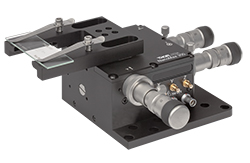
Click to Enlarge The MAX3SLH can be Mounted Directly to our 3-Axis Nanopositioning Stage
- Perfect for Integration into our Optical Tweezer Kit
- Dimensions: 101.6 mm x 68.6 mm x 12.7 mm (4" x 2.7" x 0.5")
The MAX3SLH Microscopy Slide Holder offers your motion control stages the ability to mount petri dishes and glass slides for integration into personalized microscopy setups such as our OTKB optical tweezers. One set of four 6-32 (M3) counterbores and one set of 1/4"-20 (M6) slots allow mounting versatility. The spring clips are also rotatable to accommodate easy swapping of petri dishes and glass slides.

The OTKBTK is designed for use with our OTKB Modular Optical Tweezers and our EDU-OT3 Educational Discovery Kit. It allows users to quickly prepare a sample and test for optical trapping once they have completed construction. Included with the kit are the following:
- Non-Drying Immersion Oil for Microscopy, Cargille Type LDF
- Not for Use with EDU-OT3(/M)
- Non-Functionalized Fused Silica Beads in Deionized Water, Ø2.06 µm, 2 g/ml
- Mini Pipette with a 50 µL Volume
- Two Plastic Slides with Built-In Channel, 400 µm Height, 100 µL Volume
- 5 Microscope Glass Slides with Reaction Wells, Ø10 mm, 20 µm Deep
- 100 Pieces of 18 mm x 18 mm Cover Glass, No. 1.5 Thickness
- Dropper for Immersion Oil
 Products Home
Products Home











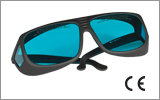
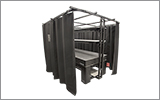
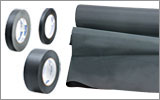
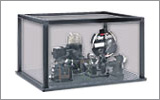
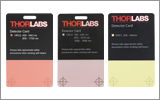
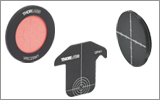
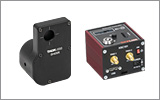
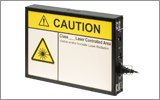
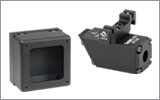
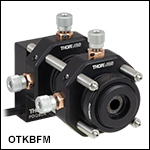
 Zoom
Zoom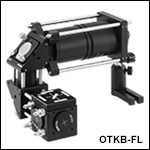
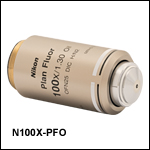
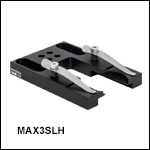
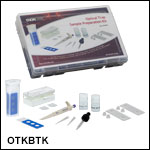
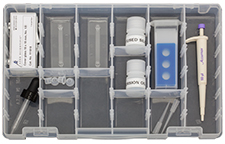
 Modular Optical Tweezers
Modular Optical Tweezers